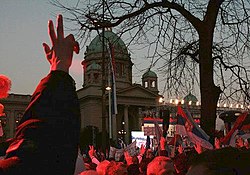Serbian three-finger salute

The three-finger salute (Serbian: три прста, "three fingers"), usually known as the Serb salute, is a salute which, at first, represented the Holy Trinity, was used when making oaths, and as a symbol of Serbian Orthodoxy, but today it is usually a gesture for ethnic Serbs and Serbia. It is made by stretching out the thumb, index, and middle fingers of one or both hands.
In Serbian and Orthodox tradition, the number three is very important.[1] Three fingers are used when signing the cross in Orthodoxy, to represent the three parts of the Trinity. In history, Serbs used the three-finger salute when they were making oaths.[1] Often, the salute was done with both hands above the head.[2] A Serbian proverb says that "There is no cross without three fingers" (нема крста без три прста).[3] Karađorđe was made the leader of the First Serbian Uprising after all the members of the uprising raised their "three fingers in the air" and by doing that swore an oath to him.[4]
| “ | the salute remains a distinctive sign for the ethnic Serb and a symbol for belonging to the Serbian nation.[5] | ” |
References[change | change source]
- ↑ 1.0 1.1 A. Palić (2013-12-07). "Prkos raširio tri prsta". Novosti.
- ↑ Traian Stoianovich (1 September 1994). Balkan Worlds. M.E. Sharpe. p. 48. ISBN 978-0-7656-3851-9.
- ↑ Vladimir Ćorović (1921). Pokreti i dela. Izdavačka knjižarnica Gece Kona. p. 9.
- ↑ M. Đ Milićević (1876). Knez̆evina Srbija. Vol. 1. Sloboda. p. 251.
- ↑ Anamaria Dutceac Segesten (16 September 2011). Myth, Identity, and Conflict: A Comparative Analysis of Romanian and Serbian Textbooks. Lexington Books. pp. 145–. ISBN 978-0-7391-4867-9.
